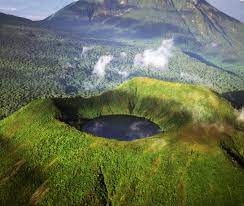+250 789 319 234
info@goprimateadventure.com
NM 12 St, Musanze - RwandaAbout us |
Book Now |
Web mail |
Blog |Travel Tips
Hiking Mount Bisoke should be on your your list of things to do while in Rwanda. Mount Bisoke also known as “Visoke” is one of the active volcanoes found within the Virunga ranges of mountains found in East and Central Africa. With a height of 12,175 ft, Mount Bisoke lies within the borders of Rwanda (Volcanoes National Park) and DR Congo (Virunga National Park). The summit and greater part of the mountain is in Rwanda. The mountain was formed as a result of a rift that is gradually dividing sections of East Africa. It has two crater lakes – one at the very top and the other (Lake Ngezi) found midway. Its last eruption was in 1957, giving it the biggest Crater Lake within the Virunga mountain ranges.
Mount Bisoke is a home to the endangered mountain gorillas and which are by large Rwanda’s more valuable tourism resource. The rich bamboo forests and other vegetation surrounding the mountain provide ideal shelter and food for these great apes. However Hiking Mount Bisoke and reaching the summit is also a favorite activity of many visitors to the Volcanoes National park. Many visitors to the Volcanoes National Park combine gorilla tracking with hiking Mount Bisoke.

Hiking Mount Bisoke is an adventurous and exciting activity that can be done by even inexperienced hikers. Hiking up to the summit takes 6 hours while coming down 2 depending on how frequently the hiking team stops for a rest. Seasoned mountain climbers can climb the mountain in 3 hours. A Mount Bisoke hike is considered less demanding but hikers should be in fine form and prepare to deal with the thorny plants, stinging insects and muddy trails especially during the rainy season. The mountain is steep but manageable for most hikers. The temperature and oxygen levels can get so low making it tiring without having to stop frequently for a rest.
Bisoke hiking is popular among visitors to the Volcanoes National park in Rwanda because of the possibility of viewing the fog filled summit, crater lakes, stunning views and alpine vegetation found nowhere else on earth. The volcano is a habitat for forest elephants, buffalo, mountain gorillas, golden monkeys and several bird species. It is possible to meet one of the gorilla families or golden monkey troops along the trail which would make for an even more fulfilling experience. However visitors are only allowed at most 10 minutes to see the gorillas from a distance. Taking photos of the gorillas during the hike is prohibited – This opportunity is only reserved for visitors who have come for gorilla tracking. The mountain gorillas and golden monkeys you spot on the way may be wild (not habituated) hence keep a distance.
Hiking Mount Bisoke usually starts in the morning at the Kinigi park headquarters with briefing from an assigned ranger. The offices can get filled with tourists because it’s the same place visitors who have come for other activities like gorilla trekking, golden monkey tracking and visiting the Diane Fossey grave get signed off. You will be required to show your hiking permit, passport and other documentation. This is the last time you will get a chance to use a decent/proper toilet (bush toilets during hiking) and snack until you come back from the summit. After registration and briefing, hikers are then transferred from the park offices to the starting point by their company guide or a hired taxi for those coming on their own.
In order to prepare well for hiking Mount Bisoke, you need to first ensure that you are fit and up to the task ahead. We see many hikers abandon the climb at the beginning of the trail only because of the mud. You need to prepare mentally with the intention of completing the hike regardless of the challenges you encounter. Prepare to carry the following items:
